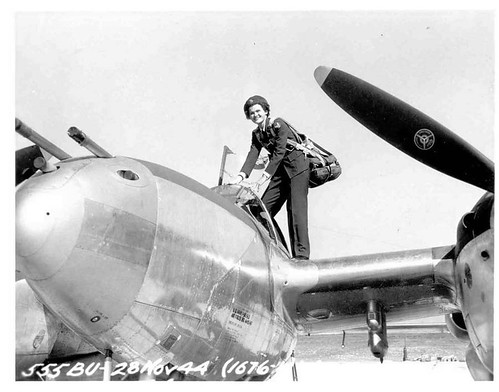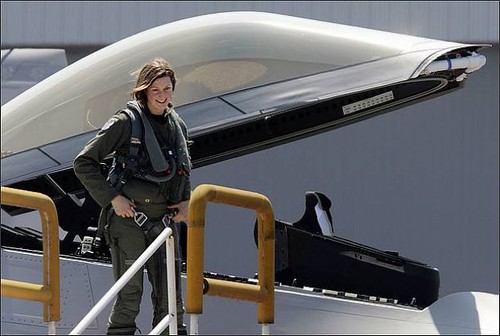When I tell visitors about the Pima Air & Space Museum’s F-14 Tomcat, I always work in a few words about women in military aviation. The Tomcat seems like the right place to introduce the topic: first because the US Navy, along with the US Army, led the way in training woman aviators in 1974, a full two years before the US Air Force got on board; second because after combat restrictions were lifted in 1994 some of the very first woman fighter pilots were naval aviators assigned to the Tomcat.
Time constraints keep me from saying much about the overall topic of women in civil and military aviation, and that’s a shame because there’s a lot to say. We’ve all heard about Amelia Earhart and Anne Morrow Lindbergh. We’ve all heard about the WASP pilots and crews who test-flew American fighters and bombers and ferried them from the USA to overseas combat bases during WWII. I mention these women too, but in a 50-minute tour there’s never time to do more than scratch the surface.

Who, outside Russia, knows about the USSR’s women fighter pilots who flew against the Luftwaffe? Who remembers Bessie Coleman, who in 1921 became the first African-American woman to earn a pilot license? Or Helen Richey, who was hired by Central Airlines in 1934, becoming the first woman airline pilot? Or Jacqueline Cochran, in 1953 the first woman to break the sound barrier? Or Jerrie Mock, who in 1964 became the first woman to finish what Amelia Earhart started in 1937, and did it solo in a single-engine Cessna? If there was ever a doubt in your mind that women catch the same flying bug that has infected generations of young men, a glance at this list will fix that.
When I write about flying, I try to inject personal experience. Sadly, when it comes to women in military aviation, I don’t have much (personal experience, that is). What little I do know is limited to the US Air Force and largely confined to fighter aviation, so I won’t speak outside those boundaries.
Military aviation was male-only when I went through pilot training in 1974. Although the Navy and Army began training female pilots that year, my service didn’t follow suit until 1976, and women didn’t start flying in operational Air Force units until 1977. I was a T-37 instructor pilot at an Air Training Command base in Oklahoma from 1975 to 1978; the first woman instructor pilots didn’t arrive at that base until after I’d transferred to the F-15. Fighters, unlike trainers, were still off-limits to women, and stayed so until 1994. By the time women began flying fighters in the Air Force, it was the second half of the 1990s and I was in a ground job, soon to retire. To my regret, I never had the opportunity to fly with women pilots.
After I retired from the military in 1997 I went to work as a civilian contractor, teaching flight safety to USAF pilots and aircrews at bases in the US, Korea, and Japan. That was when I finally started meeting, and training, woman fighter pilots. Their numbers were so small I can count the ones I worked with then on the fingers of one hand: one F-15 pilot and three A-10 pilots (I got to know two of the A-10 pilots reasonably well and am still in touch with both today, although by now they’re retired like me).
There was a lot of resistance to women pilots inside the military, first in the 1970s when they began to fly non-combat military aircraft, then again in the 1990s when they started flying fighters and bombers. Senior military leaders and old-school pilots from the men-only days pulled out all the stops: they’ll have to have separate locker rooms and restrooms; we won’t be able to tell jokes and sing dirty songs at the bar; women aren’t physically capable of pulling Gs; they’ll get knocked up and grounded if there’s ever a threat of actually going to war; if they do go to war with us and one of them gets shot down the American public will revolt … and on and on (and on, and on).
An interesting subset of resistance came from military wives, who worried about what might happen when their husbands were on alert or away on temporary overseas duty with woman pilots. Never mind that woman military aviators are generally married themselves, with spouses at home.
When I was flying F-15s at Kadena Air Base in Okinawa in the early 1990s, there were two or three woman pilots and navigators assigned to the AWACS and tanker units there. We fighter pilots knew them professionally (we planned and flew missions and deployments together); along with our wives we knew them socially (we all drank at the same officers’ club). Some of the same tensions existed then; women in flight suits were rare and many of the wives distrusted them. Donna and I got to know one of these women, a KC-135 navigator, pretty well, and we stayed friends for years afterward.
At least in the USAF, I think the resistance has run its course. Women, of course, fly airplanes as well as men. They’re motivated and have proven themselves in combat. Some have died in accidents, some have been shot down, some have even been POWs. The American public did not revolt, the world did not end. There have by now been several woman fighter squadron commanders (one of my friends was one) and a few woman wing commanders. Women fly with the Thunderbirds and Blue Angels.

Their numbers are still small, though, especially compared with overall numbers of women in the military. Speaking of the USAF alone, while almost 20% of the overall officer and enlisted force is female, women make up only about 5% of the pilot force. I understand the same ratio holds true for the US Navy and the civilian airline industry. I don’t know if that means anything, or if any conclusions can be drawn from it. Cultural conditioning may play a role; we still tend to think of certain occupations as male or female … but what do I know?
Why aren’t more women drawn to military aviation? Reader comments welcomed!
A friend from the Netherlands sent some info on women fighter pilots. It comes from Wikipedia (link: http://en.wikipedia.org/wiki/Fighter_pilot#Women_fighter_pilots). It’s accurate as far as it goes, but ignores naval aviation for some reason. Many of the first female pilots in the US military flew for the Navy, and I’m not sure why the wikipedia author left them out. But FWIW, here’s the info my friend sent, and it’s especially interesting from an international perspective:
Women fighter pilots\
Until the early 1990s women were disqualified from becoming fighter pilots in most of the air forces throughout the world. The exceptions being Turkey where Sabiha Gökçen became the first female fighter pilot in history in 1936 and went on to fly fast jets well into the 1950s,[4] and the USSR during the Second World War 1942-1945 where many women were trained as fighter pilots including Lilya Litvyak who became the top scoring woman ace of all time with 12 Kills and Katya Budanova a close second with 11 kills, although both were killed in combat.[5]In the last decade of the twentieth century a number of air forces have removed the bar on women becoming fighter pilots (see below):
Turkey – In 1936 Sabiha Gökçen became the world’s first female fighter pilot. Since then, Turkey continues to train female fighter pilots. [6]
Canada – In 1989 Dee Brasseur and Jane Foster became the first female fighter pilots in the Canadian Air Force after qualifying to fly the CF-18 Hornet.[7]
Norway – In 1992 Mette Groetteland became the first female fighter pilot in the Royal Norwegian Air Force after qualifying to fly the General Dynamics F-16 Fighting Falcon.[8]
Netherlands – Between 1993 and 1997 Manja Blok the first female fighter pilot in the Royal Netherlands Air Force was active flying a General Dynamics F-16 Fighting Falcon over Bosnia enforcing the no fly zone. [9]
USA – In 1993 Jeannie Leavitt became the first female USAF fighter pilot, initially being assigned to a McDonnell Douglas F-15E Strike Eagle squadron, and subsequently flying 300 combat hours, mostly over Afghanistan and Iraq. [10]
UK- In 1994 Jo Salter was declared combat ready by the Royal Air Force flying a Panavia Tornado in 617 Squadron becoming Britains first female fighter pilot. [11]
Sweden – In the mid 1990s Anna Dellham became Sweden’s first female fighter pilot serving with a Viggen squadron, before in 2011 qualifying to fly the Grippen.[12]
France – In 1999 Caroline Aigle became the first woman to receive the French Air Force’s coveted fighter pilot wings. She was assigned to fly the Mirage 2000-5.[13]
Belgium – In 1997 Anne-Marie “Mie” Jansen becomes the first Belgian female fighter pilot, flying the General Dynamics F-16 Fighting Falcon. [14]
South Africa – Catherine Labuschagne got her wings in 2000 and flew the Impala and Hawk before in 2010 completing her maiden solo flight in the South African Air Force’s Gripen Jas 39C, becoming the first woman fighter pilot ever to fly the Gripen. [15]
Israel – In 2001 Roni Zuckerman became the first Israeli woman to qualify as a fighter pilot. [16]
Finland – In 2002 Inka Niskanen became Finland’s first female fighter pilot, flying F/A-18 Hornets. [17]
Singapore – In 2003 Khoo Teh Lynn became Singapore’s first female fighter pilot, flying General Dynamics F-16 Fighting Falcons. [18]
Denmark – In 2005 Line Bonde graduated from the Euro-NATO Joint Jet Pilot Training program at Sheppard Air Force Base in Texas, USA, as Denmark’s first female fighter pilot. [19]
Germany – In 2007 Ulrike Flender graduated from Euro-NATO Joint Jet Pilot Training program to become Germany’s first female fighter pilot. [20]
South Korea – In 2008 Ha Jeong-mi became the first South Korean female fighter pilot, flying the KF-16 fighter. [21]
Poland – In 2012 it was reported that Katatzyna Tomiak had become a Mig-29 fighter pilot in the Polish Air Force. [22]
China – In 2013 China publicised the graduation of six of the PLAAF’s first-batch of female fighter pilots. [23]
Pakistan – In 2013 Ayesha Farooq became Pakistan’s first female fighter pilot flying the Chinese-made F-7PG fighter jet. [24]